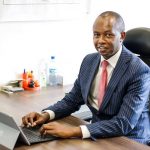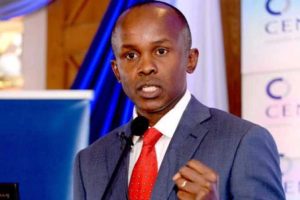[ad_1]
MR MEASSICK: Secretary Blinken, the embassy is delighted to have this unique opportunity to engage with you on clean energy. Kenya is not only a leader in the region, but also poised to become a global leader for clean energy and climate action. Currently, 90 percent of Kenya’s power is generated from renewable sources with 40 percent generated from geothermal, 45 percent from hydropower, and the remainder from wind and solar.
Our assistance facilitated over 3 million off-grid and on-grid connections for homes and businesses across the country, bringing electricity to over 10 million Kenyans for the first time. This virtual tour will provide you with a glimpse of the nearly $600 million in U.S. financing across geothermal, wind, and solar renewable energy investments.
MS JAIN: I’m Vibhuti Jain, regional managing director for Africa at the U.S. International Development Finance Corporation, or DFC. I am pleased to introduce you to Kipeto Wind Farm, a transaction that will begin operations this spring. Kipeto will deliver 100 megawatts of clean energy to the Kenyan people, powering a quarter million households. This Power Africa project was made possible in partnership with Kenyan, international, and American investors with financing and insurance from DFC.
MS WALKER: I’m Lisa Walker, energy office director for Power Africa, a U.S. Government-led initiative to connect 60 million new homes and businesses across sub-Saharan Africa to clean, reliable energy, leveraging the expertise and the resources of 170 public and private sector partners. In Kenya as elsewhere, it’s the missions that drive results. I’m pleased to introduce you to Powerhive, a U.S.-owned innovator in the Kenyan mini-grid space and one of our partners.
MR MEASSICK: The companies we support are located in national parks and on privately owned community land, but they conduct their business in a socially and environmentally responsible way. They build tunnels for wildlife to pass through their site. They are partnering with the local community who benefit from the revenue. And with the access to electricity, women no longer need to cut down trees for firewood.
While Kenya has aggressively connected households and businesses in the national grid, increasing access from 23 percent to 75 percent of the population over the last eight years, currently 40 percent of rural areas are still not covered by the grid. That’s primarily because it is too expensive to extend the grid to those remote areas in the near term.
The U.S. Government has a unique opportunity to affirm our global leadership and commitment to major climate action.
SECRETARY BLINKEN: Greetings.
MS FERTIK: Greetings, Mr. Secretary. How are you?
MR NAMUNJE: Hello.
MR HORNOR: Hello.
SECRETARY BLINKEN: Very well. Good to see you all.
MR NAMUNJE: Yes. How are you?
MS FERTIK: All right.
SECRETARY BLINKEN: Thanks so much for doing this. Really appreciate it.
MR HORNOR: A pleasure.
MR NAMUNJE: Thank you.
MS FERTIK: And hello, Secretary Blinken. It is truly an honor to welcome you virtually to Kenya for a conversation today on U.S.-Kenya partnerships for clean energy. My name is Emily Fertik and I’m the Information Officer here at the U.S. Embassy in Nairobi. And with me today, as you have just met, are leaders from the two companies that you have heard about in the introductory video.
To my immediate left is Dr. Kenneth Namunje, Chairman of the Board of Kipeto Energy. Dr. Namunje has been instrumental in the development of the Kipeto Wind Farm project. He has worked with local and national stakeholders to ensure that it becomes a reality.
And to my far left, Mr. Chris Hornor, President and CEO of Powerhive. Mr. Hornor, who hails from California, has been an entrepreneur and pioneer of consumer renewable energy products for well over a decade in East Africa.
Mr. Secretary, allow me to turn it over to you to start our conversation with a few opening remarks.
SECRETARY BLINKEN: Well, Emily, thank you very much, and thank you for bringing us all together. And Dr. Namunje, Mr. Hornor, really appreciate you joining me for this conversation. And to everyone at your companies as well who’ve helped to make this possible, thank you, thank you, thank you.
I’m really eager to ask some questions about your work and Kenya’s clean energy sector, because I think a lot can be learned from the progress your companies and the country have made toward providing sustainable energy to the Kenyan people. There are lessons there that go well beyond Kenya.
I am pleased and proud that we’ve been a strong supporter of this effort. We invested in your companies. That includes financial support, like the $230 million in loans that the Development Finance Corporation provided to Kipeto and – Wind Farm, but also technical support like the kind Power Africa gives to Powerhive to help build the 23 mini grids.
These and other American investments in Kenyan hydropower, solar, wind projects have helped Kenya reach a point where – this is remarkable – more than 90 percent of its electricity now comes from renewable energy sources. And the country is on track to provide universal energy access by 2022. That’s obviously very good for the Kenyan people, it’s good for the Kenyan economy; it’s also good for the planet, and so I think there’s something very powerful going on.
The only way we’re going to address the climate crisis is by reducing the world’s carbon emissions, and that means, ultimately, clean and renewable energy. So we need to help more countries do what Kenya has done and we need to raise our ambitions on climate more broadly. Our administration, the Biden-Harris administration, is committed to reclaiming America’s leadership on this front. As you know, on day one, President Biden rejoined the Paris Agreement, and we will meet our domestic commitments.
But here’s what we know: Delivering at home is not enough, and that’s exactly why President Biden has worked to raise ambition and increase resilience at the global level, including through the Leaders Summit, and it’s also why, as Secretary, I’m ensuring climate change is at the center of our diplomacy. Anything less will fail to address this emergency. And of course, in that effort we have the remarkable secret-but-not-so-secret weapon of Secretary John Kerry leading our efforts around the world.
As we’re taking these steps, there are two lessons that I at least take from the progress that you and others have made in Kenya. One is that governments need to collaborate more with the private sector. Your success has proven that investing in sustainable energy can be both effective and profitable. The second lesson I take from this is how important it is to meet a range of needs at different scales. On the one hand, we need massive projects like Kipeto, which will provide energy to 250,000 households on the grid. We also need smaller-scale projects like Powerhive, which will reach low-income communities that have never had electricity before. We can meet our sustainability goals without writing off communities that are harder to reach, and that way they can access the opportunities enabled by energy access as well.
So this gets me – it’s a long way of getting to what I really want to come to, which are some questions, because we want to learn from your experience and your insights. So a couple of questions if it’s all right to both of you, and the first is: Tell us about the impact that loans and capital investments have on starting up these ventures. What role do they play, and in your experience at least, how critical are they to being able to move forward?
MS FERTIK: Dr. Namunje, let me start with you.
MR NAMUNJE: Thank you. Thank you, Secretary Blinken. I’ll say that with the support of the DFC granting us $233 million, enabled the project to reach financial close. And I would also say that through Power Africa, the U.S. Government helped us to develop our biodiversity action plan, which really focuses on minimizing the possible human-wildlife contact around the Kipeto site. And I would also say that the private sector has done its part as well because our international equity shareholder in Kipeto called Actis has more than half of its investment base comprising of American investors, including a significant contribution from the pension fund of American civil servants. I would also say, like, for instance, GE has supplied our highly efficient wind turbine, which is a 1.7-megawatt turbine.
And so in short, I would say that the U.S. Government assisted in financing and has supported us to meet our compliance to the highest international environmental and social standards, which underpins also the technology capacity that the project is built on. Yeah, yeah.
SECRETARY BLINKEN: Great.
MS FERTIK: And Mr. Hornor?
MR HORNOR: Thank you for having me, Mr. Secretary. So Powerhive was started in 2011, and around 2015 we became Kenya’s first privately licensed utility offering clean, renewable energy sources to now over – close to 6,000 households. And early in our development, we received about a half a million dollars from the U.S. Government, which helped us to spur economic development and create jobs and create businesses that would not only put money into the pockets of our customers, but also allows – allowed us to innovate in new businesses that would also sort of surround the mini grids that we developed.
So today, with that investment, we’ve been able to start a chicken business which is putting a lot of money into the pockets of our customers. We’re now one of the leading chicken producers in Kenya. And from that, we’ve also now created a whole electric mobility platform also based on U.S. R&D and things that we’ve done there. So we’re pretty excited about these early developments that the U.S. Government helped in terms of that early investment to try innovative new things that has led to some pretty remarkable progress.
SECRETARY BLINKEN: Well, it’s really good to hear that from both of you and looking at different angles of this, because I think that what we can do in government is help to be a catalyst for the work of the private sector. Our greatest strength in the United States is the private sector, but the government, I think, has a vital role to play in, as I said, being a catalyst and being a partner. And the strength of these public-private partnerships in various ways, whether it’s through something as large as the DFC or whether it’s through smaller loans or guarantees or insurance, seems to be potentially the real difference maker in our ability to get things done. So I’m really glad to hear that.
Another question is this. Meetings like President Biden’s Leaders Summit on Climate I think are also important ways to learn from each other, to compare experience, to compare best practices, to hear what’s worked, what hasn’t worked. And so what I’m curious about is whether, in your experience, you have business ideas or innovations around green energy that we should be exploring in the United States or, for that matter, sharing elsewhere.
MS FERTIK: Dr. Namunje, your ideas, please.
MR NAMUNJE: Thank you, Secretary Blinken. So I’ll say that Kenya is a model for clean energy generation in Africa with around about 90 percent of our power coming from non-fossil fuel sources. But the next challenge for Kenya and the U.S. is the impact of the variability of clean energy resource from the grid through investment in battery storage. And we know that the U.S. is a global leader in battery storage technology.
So we then ask Kipeto shareholders, Actis and Craftskills, which I chair both. Craftskills is a local share partner. We’re actually exploring opportunities on how to integrate battery storage into the wind farm with the support of the U.S. Trade and Development Agency. And so I’ll say that this is an area that we would love to engage with U.S. companies on and how to make this move on, and that’s an opportunity that is there.
MS FERTIK: Mr. Hornor, I know you’ll have more ideas.
MR HORNOR: So I’m fortunate. I’m one of the handful of U.S. companies based in Kenya that are really leading the charge in terms of off-grid and sort of distributed generation and storage for communities in this sector. So when I look at sort of the knowledge that we have actually developed and gained through the last – coming up to 10 years in creating highly efficient solar-powered solutions that combine electric mobility and other sort of agricultural practices, we think that when we look in particular especially on the sector we’re developing here around mobility, working with companies in Detroit and figuring out some of the best technology that’s coming out of these areas would be incredibly valuable to us.
So given that they’re a huge cost center, I think there’s a lot we could do to collaborate and not only bring some of our sort of learnings there but also learn from some of our partners in the U.S. that we’d love to sort of work with in more details. So it’s – as we look at sort of northern California and other places that are being hit by climate change, some of these distributed generation plus storage and efficient distribution systems that are not connected to a bigger grid I think are going to be really important lessons that we can learn to reduce the cost for maintenance of some of these remote areas of the United States even. So there’s some interesting sort of synergies I think we can – we’ll see.
SECRETARY BLINKEN: Well, go ahead Emily.
MS FERTIK: I was going to turn it right back over to you, Mr. Secretary, if you would like to wrap up our conversation with closing remarks.
SECRETARY BLINKEN: Yes. And thank you both, because I think when it comes to climate and energy, we’re all feeling increasingly the fierce urgency of now. And to your point, Mr. Hornor, just what so many different communities in the United States are experiencing in terms of the effects of climate change are, of course, increasingly acute. And that just emphasizes the need to act, but to act in a smart, informed way, based on experience, based on sharing ideas, best practices, knowledge.
And so much of that is actually being accumulated by companies like yours and endeavors that you’re engaged in in different ways. And so finding ways to make sure we’re having the sharing of ideas, of information, that we’re bringing people together in government, across governments, in the private sector, NGOs – all of that is very much, I think, part of the solution.
And what I have seen in looking at what you’ve been doing, watching the video, hearing both of you, it strikes me that Powerhive and Kipeto are really excellent examples of how the United States is promoting partnerships with U.S. firms and, in this case, advancing Kenya’s leadership – not just in Africa but really beyond – for sustainable, renewable energy. And that’s going to be a powerful example and a powerful lesson, I think, for the entire world, because we’re seeing that Kenya is not only a leader in the region but is poised to become a global leader for clean energy and climate action.
So I’ve got to just tell you we’re very pleased to be working with partners in Kenya to affirm global leadership and commitment to major climate action. So for today, just thank you for coming and sharing your thoughts. But for every day, thank you for what you’re doing, because you’re making climate action real; you’re making access to energy real, including for underserved communities. And I think that’s going to have a powerful, positive impact going forward. So it’s a pleasure to get to spend at least a few minutes with both of you, and I look forward to hearing more in the days and weeks ahead.
MS FERTIK: Mr. Secretary and Dr. Namunje and Mr. Hornor, thank you all for your time. And thank you for a truly thoughtful conversation today on the opportunities for expanding clean energy in Kenya. Thank you all and have a good day.
Source link


















